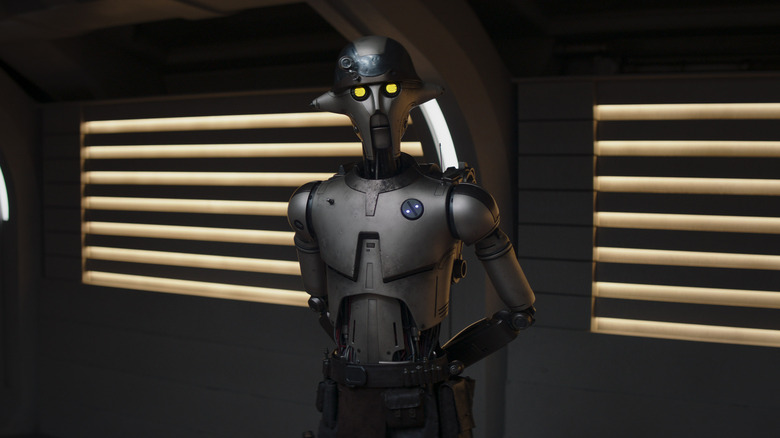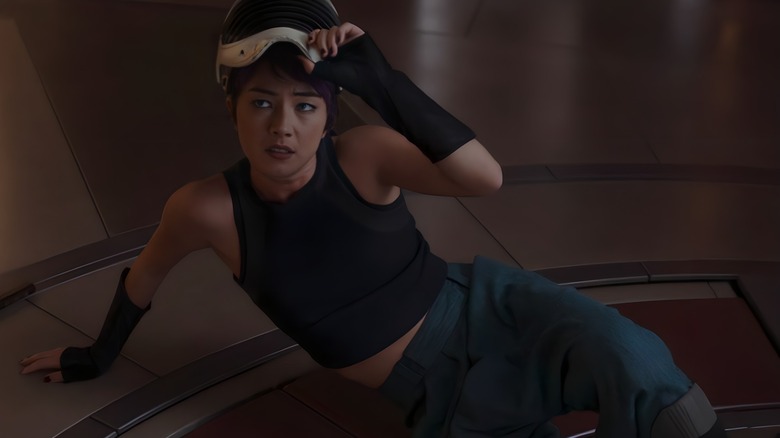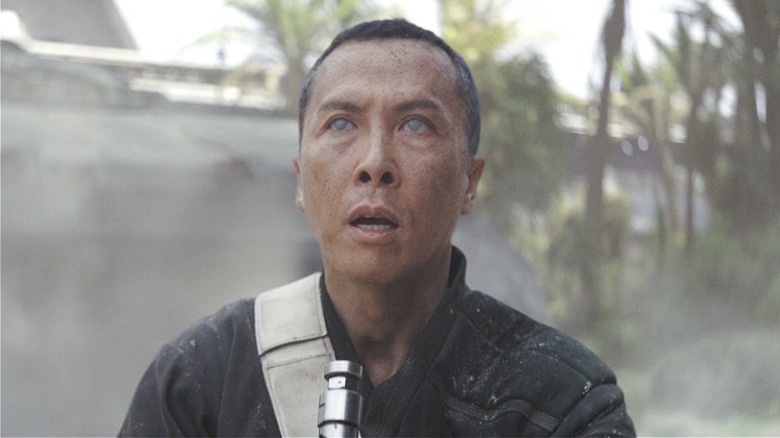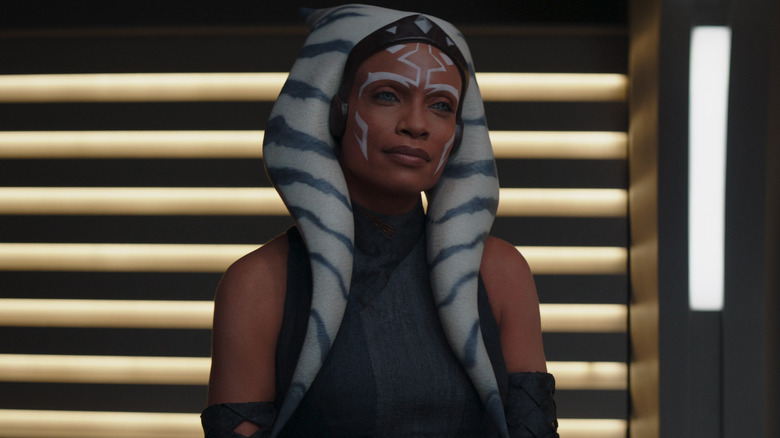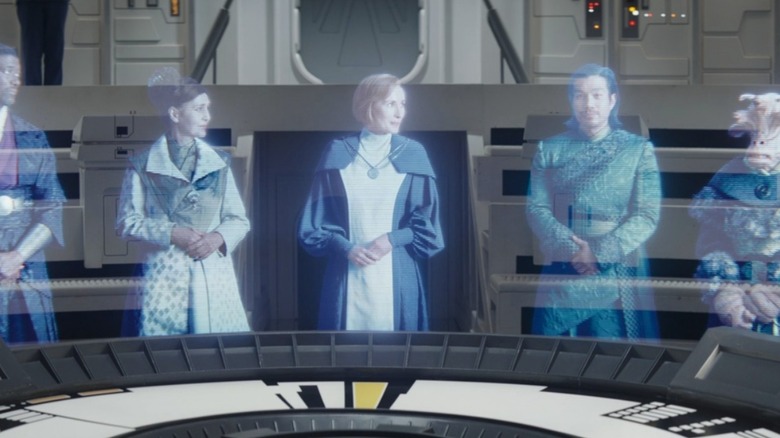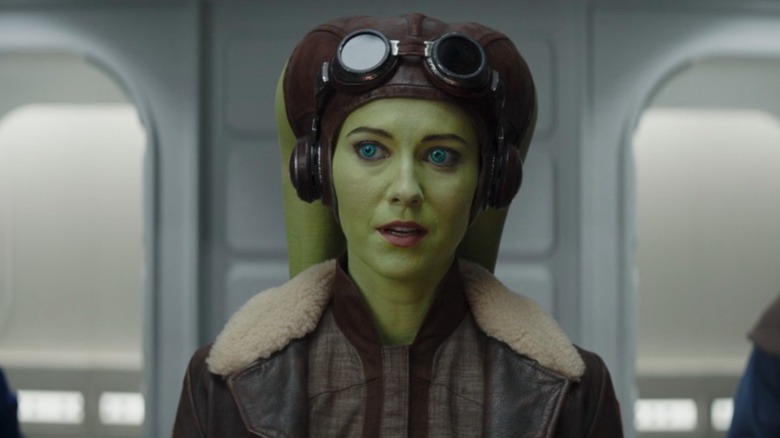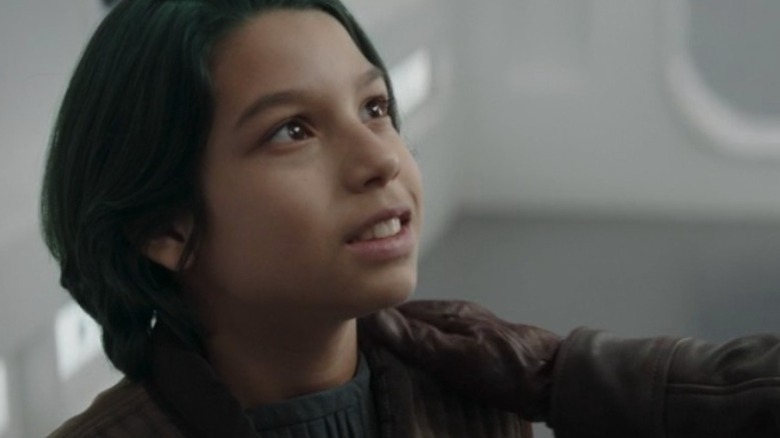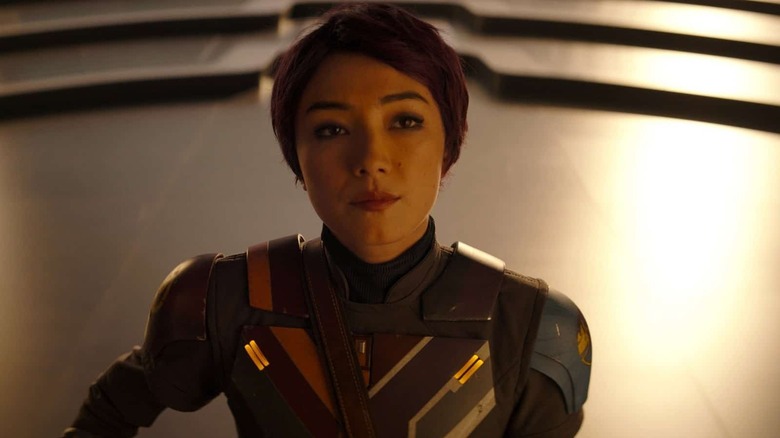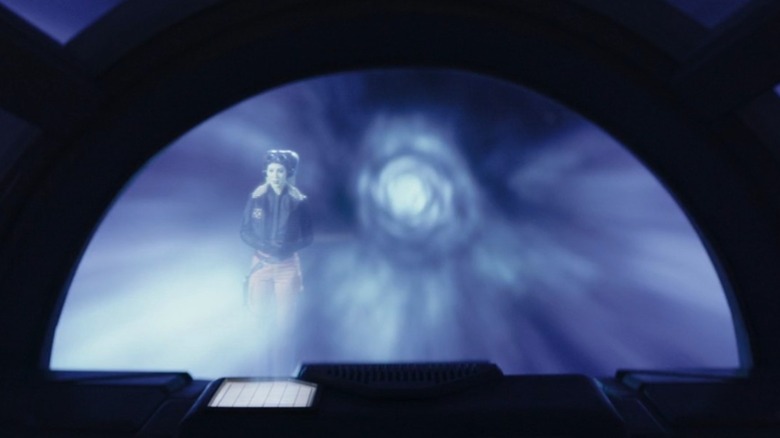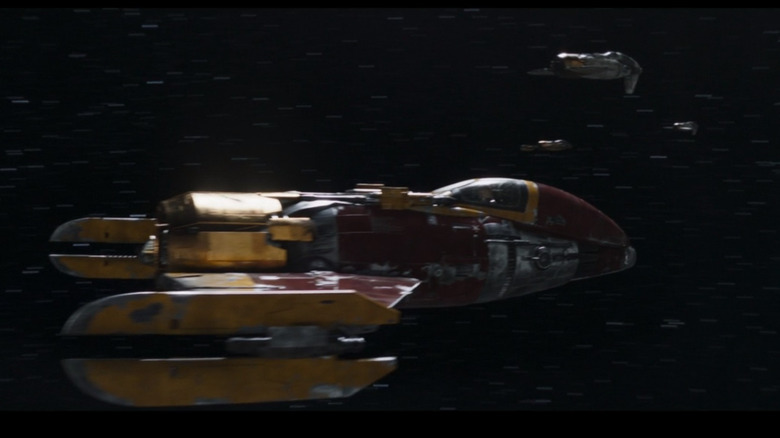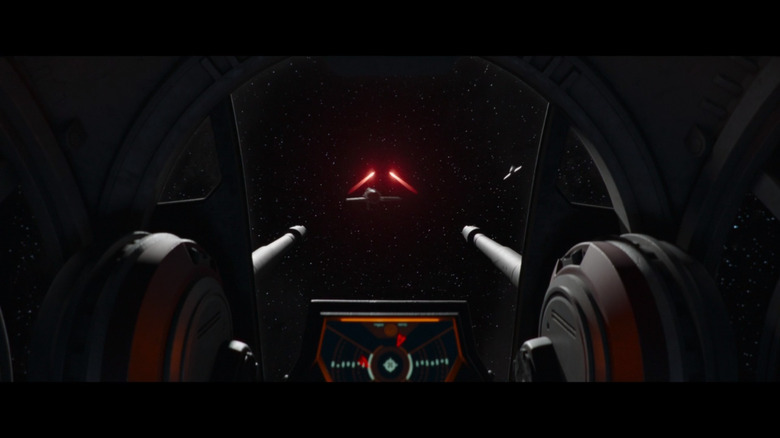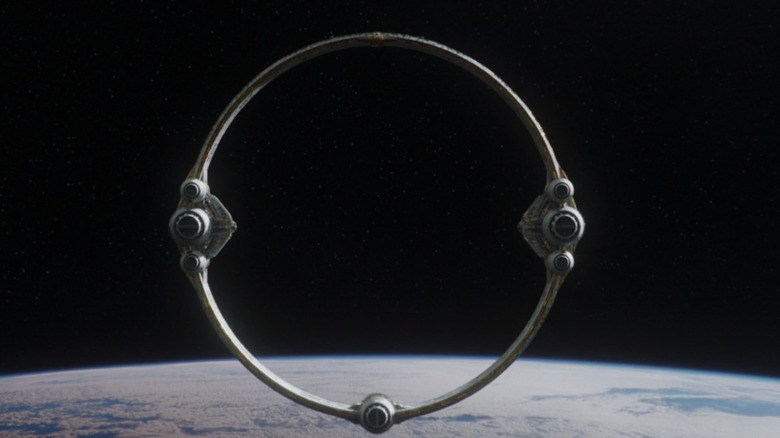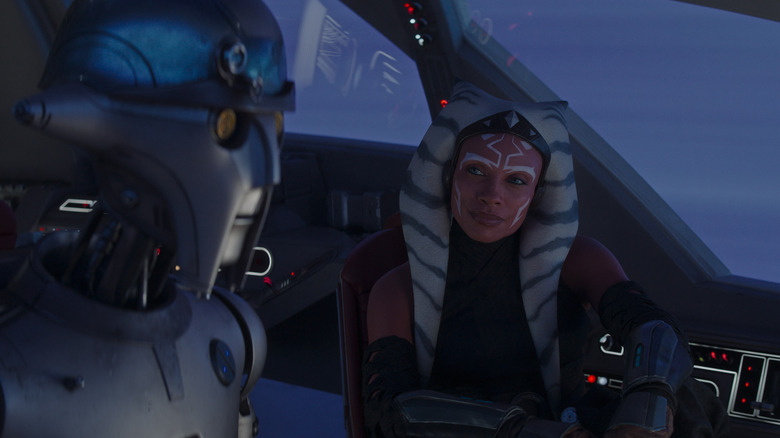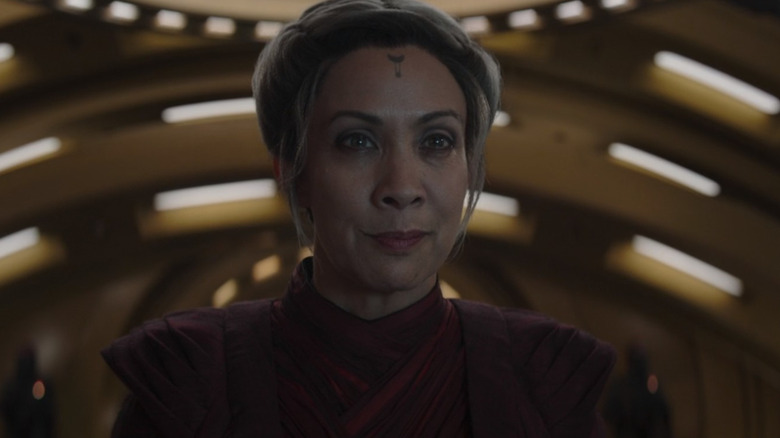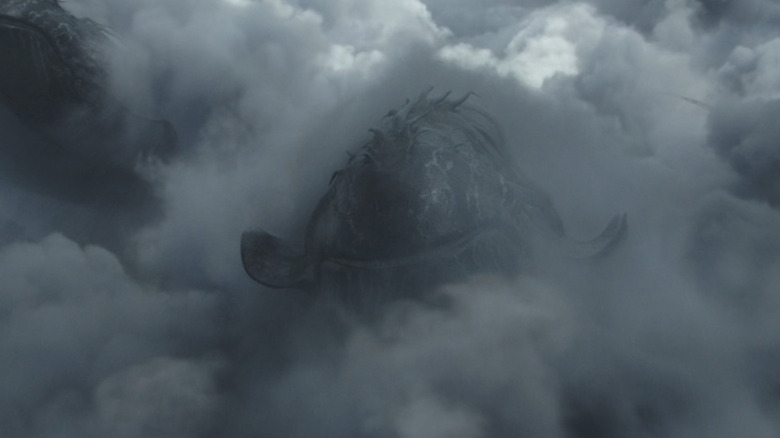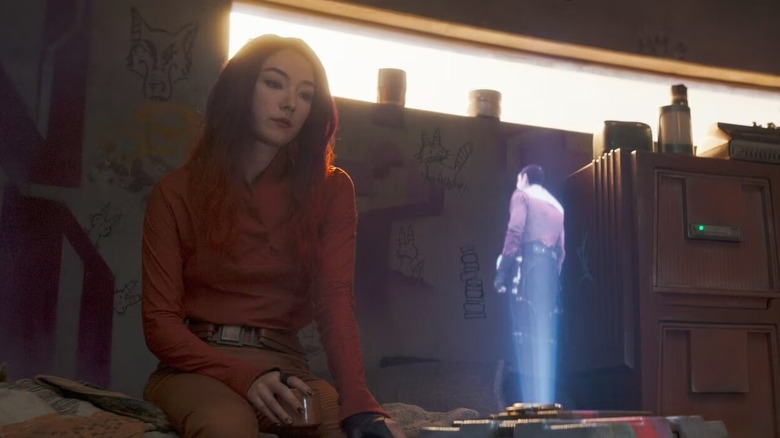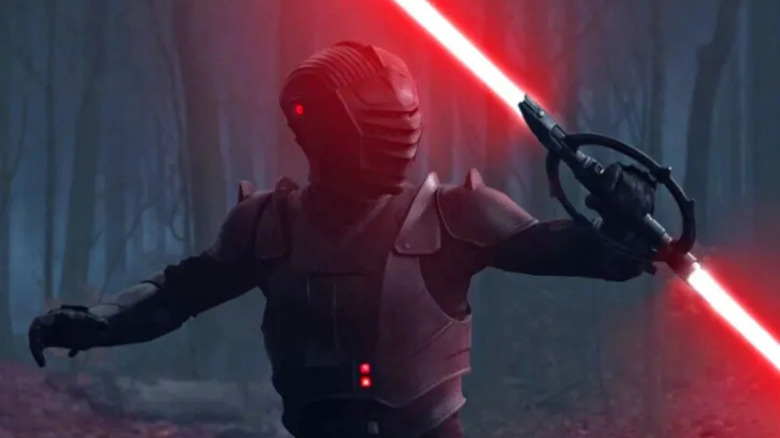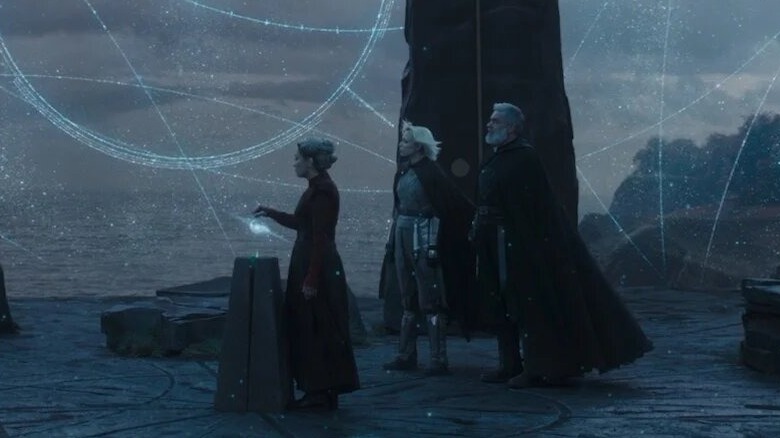Ahsoka Episode 3 Breakdown: Easter Eggs, Small Details & Ending Explained
Contains spoilers for "Ahsoka" Season 1, Part 3 — "Time to Fly"
Two episodes of buildup have introduced all the main players of "Ahsoka," and where they stand in the larger story. Now that Ahsoka Tano (Rosario Dawson) and Sabine Wren (Natasha Liu Bordizzo) have made amends and resumed their mission to find Grand Admiral Thrawn (Lars Mikkelsen) and Ezra Bridger (Eman Esfandi), "Time to Fly" embraces the show's nature as a live-action "Star Wars Rebels" sequel.
After Episode 2 ended with Ahsoka and Sabine burying the hatchet, this one opens with the purple-haired Mandalorian resuming her Jedi training in full. However, that's far from the only thing that happens here. From stubborn politicians to cool space battles, "Ahsoka" Episode 3 packs a lot of punch in its comparatively short runtime — so much, in fact, that it's borderline impossible to catch it all without repeat viewings and extensive knowledge of both deep-cut "Star Wars" lore and certain real-world concepts. With that in mind, here's a full breakdown of the various Easter eggs and small details of "Time to Fly," as well as a look at what its ending could mean for the show's future.
Huyang and Sabine's lightsaber drill means more than you think
After a quick recap of the story so far, "Ahsoka" Episode 3 opens with a tried-and-tested Jedi training sequence. As Ahsoka walks in the room, we see Huyang (David Tennant) working on Sabine's sword skills with a technique that involves Sabine performing different attacks on the hologram sabers in Huyang's four arms. In the first but certainly not the last reference to Japanese culture in the episode, the drill is somewhat reminiscent of a samurai technique known as tameshigiri, which was used to test a blade's sharpness with a series of different cuts. Huyang not only has Sabine perform a series of such moves on command, but his holo-swords actually rank the quality of Sabine's slashes.
The fact that Huyang is supervising this particular drill makes sense. He's a truly ancient lightsaber droid who's used his skills to assist the Jedi Order in the art of lightsaber construction for many centuries, so he knows the weapon and its abilities better than most. The fact that the droid quickly hands the reins to Ahsoka when she arrives also tracks, as tameshigiri is a task that was traditionally left to lower-level samurai warriors. While Huyang is familiar with the ways of the Jedi, he's still a droid and thus can't use the Force himself. As such, he's happy to step back the second a "higher-ranking samurai" — aka Ahsoka — arrives to take over the training.
Sabine's lack of Jedi skills is becoming an important plot point
Between Huyang's and Ahsoka's training sessions, the show revisits a plot point from Episode 2. When Ahsoka chalks Sabine's weapon-handling skills up to the padawan's Mandalorian training and wants to focus on her mind instead, Sabine takes the time to inform her master about the views Huyang expressed about her lack of talent as a Jedi student.
Ahsoka isn't particularly shaken by this information. Instead, she dismisses the talent question as unimportant and moves on with the training. The viewer, however, can't help but note that the show — or Huyang, for that matter — apparently doesn't intend to give Sabine a break when it comes to her sub-par Jedi skills. More than likely, "Ahsoka" is either setting up a big moment when the Mandalorian finally finds her Force connection ... or, at the very least, finds a workaround that allows her to operate on a good enough level to beat Shin Hati (Ivanna Sakhno) in their inevitable rematch.
Star Wars pays homage to Zatoichi the blind swordsman ... again
After Huyang deems Sabine's lightsaber skills lacking, Ahsoka decides to take the training to a higher gear with a mind-honing combat training technique she calls Zatochi. This turns out to be a true "Star Wars" staple: the blindfolded training technique that made its debut all the way back in "Star Wars: Episode IV –A New Hope," when Obi-Wan Kenobi (Alec Guinness) used it to train Luke Skywalker (Mark Hamill). Ahsoka's version of Zatochi involves a similar sight-impairing helmet, but instead of whipping out a lightsaber and one of the several Marksman-H training remote drones from her impressive collection, she grabs the same kind of wooden training sword Sabine is using and faces off against her.
"Star Wars" has never shied away from depicting the Jedi as space samurai, and the Zatochi technique continues this episode's Japanese references. The name is a nod at the classic blind swordsman character Zatoichi, who's low-key a very popular figure in the Galaxy Far, Far Away. Apart from the various times the Jedi have honed their lightsaber skills blindfolded, "Rogue One: A Star Wars Story" character Chirrut Îmwe (Donnie Yen) is essentially a Zatoichi expy in a sci-fi setting.
As a cherry on top of the samurai cake, the training swords Sabine and Ahsoka use are bokken — Japanese wooden swords. Legendary swordsman and artist Miyamoto Musashi famously won one of his duels with such a weapon. Could this foreshadow Sabine's weapon of choice when she takes on Shin?
Ahsoka's unique position among Force users has given her valuable insight (and some very cool powers)
By now, most "Star Wars" fans have a pretty good idea of the sort of people who prefer the light side of the Force and the ones who are corrupted by the dark side. Ahsoka, being a Jedi outcast who nevertheless hasn't succumbed to the dark side, is a pretty unique case on this sliding scale. Her white lightsabers reflect her status as a non-Jedi light side Force user, and the beginning of "Ahsoka" Episode 3 provides a stealthy reflection on the character's place in the grand scheme of Force things.
Ahsoka's "neutral good" status seems to have given her a fairly rare power set. Apart from the already formidable powers she had in the animated series, the live-action Ahsoka has already used a rare power known as the Force Echo. As she trains the blindfolded Sabine, she somehow manages to move from one part of the room to another in the blink of an eye, offscreen and unheard. Sure, this could be because Ahsoka is just that good. However, it could also be a stealthy implication that Ahsoka has access to Force Teleportation, an extremely rare technique that tends to be more popular among those who use the dark side of the Force.
The live-action Ahsoka is also somewhat calmer and more mature than she used to be back in the day, and as her words of wisdom to Sabine prove, her peculiar status as a Force user has certainly given her plenty of insight. "Anger and frustration are quick to give power, but they also imbalance you," Ahsoka delivers a one-sentence summary of the line between the Jedi and the Sith.
The return of Mon Mothma
While Ahsoka and Sabine continue their training and make their way toward the Denab system, Hera Syndulla (Mary Elizabeth Winstead) is on a mission of her own. Desperate to help her friends, squash the Imperial remnant, and prevent Grand Admiral Thrawn's (Lars Mikkelsen) return and potential rise to power, she hopes to convince the New Republic Senate Committee to provide aid. This meeting with the senators is led by none other than Chancellor Mon Mothma (Genevieve O'Reilly), who most recently appeared on the Disney+ series "Star Wars: Andor" after previously popping up in "Rogue One: A Star Wars Story" and "Star Wars: Episode VI — Return of the Jedi."
At the end of the day, Hera's goal is simple: prevent the galaxy from falling into yet another war. She mentions to the group that for virtually her entire life, she has fought in various galactic conflicts. Her father, Cham Syndulla (Robin Atkin Downes), famously led the charge against the Separatists on Ryloth during the Clone Wars and sought to counteract the Imperial occupation of the planet once the Galactic Republic fell. She was right by her father's side through it all, and later led her own missions for the Rebellion during the Galactic Civil War. Suffice to say, she understands war, which is why she begs and pleads with the committee to help her out.
The personal side of Hera's plea
In addition to wanting to prevent another galaxy-wide conflict, Hera is also meeting with the New Republic Senate Committee for personal reasons. As she explains to them, Thrawn is not an individual to be taken lightly by any means, describing him as someone far different from the average Imperial figurehead. She knows this well, seeing as she's fought against him and witnessed the kind of destruction he and his forces can rain down upon those against them. Hera and her allies' conflict with Thrawn even resulted in the demise of her romantic partner, Jedi Kanan Jarrus (Freddie Prinze Jr.), as seen in the "Star Wars Rebels" Season 4 episode "Jedi Night."
Even though her reasons for wanting to enlist the help of the New Republic are reasonable, the committee is far from convinced. Most vocal among them is Senator Xiono (Nelson Lee), who appears more than happy to shrug off Hera's concerns about Thrawn by parroting the widely-held belief that he perished. Thus, he also expresses his belief that her close friend, Ezra Bridger (Eman Esfandi), died along with him, which leads Hera to somewhat lose her cool. Much like Sabine and Ahsoka, she's still holding onto some bit of hope that Ezra is still alive, and she refuses to entertain the alternatives. The Senate Committee then deliberates in private.
Enter Jacen Syndulla
As the Senate Committee discusses her proposal and comes to a decision, Hera steps into the hallway. She then runs into her and Kanan's young son, Jacen (Evan Whitten), along with the incomparable astromech droid, Chopper (Dave Filoni). Jacen last appeared in the "Star Wars Rebels" two-part finale, "Family Reunion – and Farewell." Due to his half-human, half-Twi'lek biology, he sports a striking head of green hair in his animated debut, which has become one of his defining features to "Star Wars" fans. Thankfully, this detail has carried over into his live-action introduction.
During their short meeting, Jacen asks her about "Aunt Sabine's" Jedi training and tells her that he wants to be a Jedi too. This comment prompts a mildly concerned response from Hera, and reasonably so. After all, all she wants to do is secure a safe and happy future for her and Kanan's child, just as her parents wanted to do for her. She doesn't want him to have to see and do the things she has in battle or put a target on his back by becoming a Jedi while the Imperial remnant gains power. However, it stands to reason the Force will call to him someday. With Kanan being his father, it's all but inevitable.
Sabine's unconventional Jedi training and lineage
Moving back to Ahsoka, Sabine, and Huyang, the former two lightsaber-wielders, sit down for a chat. Sabine admits her frustration over her inability to use the Force, something she has been led to believe anyone can do, and Ahsoka reassures her that while talent is a factor, training, and dedication are vastly more important. Ahsoka then heads to the cockpit to chat with Huyang while Sabine attempts to connect to the Force to move a cup. On the topic of Sabine's progress, the droid doesn't hold back. He tells Ahsoka that Sabine is far from an ideal candidate to become a Jedi and that the Jedi Council would've never brought her in to train.
Still, Ahsoka isn't convinced that Sabine is a lost cause, noting that the ways of the Jedi Council eventually failed. Huyang points out that Sabine is one of very few Mandalorians to become a Jedi — the other notable name being Tarre Vizsla, the creator of the Darksaber — so she's certainly an outlier. Then again, he concedes that Ahsoka comes from a long line of non-traditional Jedi herself. Behind Sabine and Ahsoka are Anakin Skywalker (Hayden Christiansen), Obi-Wan Kenobi (Ewan McGregor), Qui-Gon Jinn (Liam Neeson), Count Dooku (Christopher Lee), and Yoda (Frank Oz), who all challenged the tenets of the Jedi in their own ways from time to time.
The New Republic makes the wrong choice
At last, Hera makes contact with Sabine and Ahsoka, but she doesn't have any good news to bring. Much to the chagrin of Sabine, the New Republic Senate Committee has decided not to send the New Republic fleet to the Denab system. It seems that Mothma and her fellow senators don't feel that the threat of Thrawn, who they wholeheartedly believe is indeed dead, is one that requires any attention or allocation of resources to combat. So, Sabine, Ahsoka, and Huyang are on their own due to one of what will become many instances of poor New Republic decision-making.
Basically from the moment it takes over for the Galactic Empire, the New Republic makes a series of notable missteps. The hiring of former Imperial agents, attempting to give Imperial operatives amnesty, and downplaying the strategic moves of Imperial remnant factions all plant the seeds of its own destruction. Therefore, it's no surprise that the regime crumbles after a mere few decades, falling into yet another devastating conflict — this time with the First Order. It reaches its crescendo when the New Republic Senate stationed on Hosnian Prime is annihilated by the First Order's Starkiller Base along with the entire Hosnian system.
Before Hera can elaborate further on the Senate Committee's stance, her hologram is cut off. As the planet Seatos comes into view, it becomes abundantly clear that Sabine, Ahsoka, and Huyang are in for a fight.
New evil starfighters in the Denab System
As soon as Morgan's communications jamming starts to affect Ahsoka's ship, she drops out of hyperspace. She, Huyang, and Sabine enter the Denab System and see the waiting planet of Seatos before them. It's a beautiful, quiet moment, which is quickly shattered when Shin Hati, Marrok, and a number of other henchmen attack.
The villains' ships are new, but their design feels old in a lot of ways. The simple, wide front wing and tight fuselage evoke old real-world fighter planes. Given that Dave Filoni has generally deferred to George Lucas' vision of the "Star Wars" universe, and that Lucas always wanted his space battles to pull from World War II dogfighting movies, this design feels like an intentional, retro choice. The ships, especially Shin Hati's, sort of resemble General Grievous' fighter from "Revenge of the Sith," but some also look similar in shape to the Naboo starfighters featured in "The Phantom Menace." There seem to be no astromech droids here, though, and they appear to be much cheaper and more rundown overall. The sound of their blaster cannons, however, is quite similar to that of the Naboo ships — more high-pitched than your typical "Star Wars" fighter.
Regardless, it seems likely that these fighters belong to Baylan and Shin's mercenary unit, rather than being provided by Morgan. Though Morgan did help build ships for the Imperial Navy, Shin, and Marrok's fighters are worn down and hold no resemblance to any known Imperial vessels. They aren't even all the same model. That doesn't stop them from using the patented green lasers of the Empire, though.
Classic Star Wars dogfighting
Once Shin and Marrok attack our heroes above Seatos, it's on. "Time to Fly" makes good on its title, delivering a lengthy dogfighting sequence that pulls heavily from the franchise's past. As soon as Sabine hops into the tail-gunner seat, it's hard not to think of the very first "Star Wars" and the escape from the Death Star. Han Solo and Luke Skywalker's gunner battle against pursuing TIE fighters is one of the most iconic scenes in the original trilogy, and "Ahsoka" is clearly paying homage.
From the frenetic jumps between cockpit and pursuit shots to Sabine's jubilation at blasting a fighter into smithereens, this scene has all the trappings of a classic "Star Wars" dogfight. There are even little targeting screen readouts with retro computer graphics — a staple of Lucas' Galaxy Far, Far Away from the very beginning. We don't get much explanation for the other pilots under Shin's command, and most of them don't live to tell their own stories. Their armor and helmets are quite interesting, though. It makes you wonder just how big Baylan Skoll's mercenary group is, what kind of jobs they've done in the past, and why they all dress like medieval knights.
The Eye of Sion
As Ahsoka bobs and weaves and Sabine blasts fighters out of the sky, they slowly get closer to the main attraction of Seatos: The so-called "Eye of Sion." Revealed by Huyang to be a massive hyperspace ring — much like the smaller ones used by Obi-Wan Kenobi in the "Star Wars" prequel trilogy — the installation is as awe-inspiring as it is unnerving.
Though the ring is shown at the end of Episode 2, "Toil and Trouble," we get a much better look at it here. Far from just a giant engine, the hulking device is also equipped with a bevy of Imperial turbo lasers, whose green blasts turn out to be a match for Ahsoka's T-6 Jedi shuttle. Inside Morgan's command cabin, we also see a number of protocol droids manning the various stations. All in all, it's both an impressive feat of engineering and a frightening glimpse at what the Imperial Remnant may yet be capable of.
The name of the ring isn't mentioned in Episode 3, but Morgan calls it the Eye of Sion in Episode 2. That title seems to be an intentional reference to Darth Sion, the so-called "Lord of Pain" and villain of "Knights of the Old Republic II: The Sith Lords." As an Expanded Universe (aka Legends) character, Sion has yet to be reinstated into the current Disney "Star Wars" canon. Since none of the characters in Morgan's retinue are technically Sith, this name is likely just an homage for diehard fans.
Jedi in space
Morgan's attacks briefly incapacitate both Huyang and the ship as it flies through the Eye of Sion. While Sabine tries to fix it from inside — something she does many times during her adventures in "Star Wars Rebels" — Ahsoka puts on a spacesuit and steps out into the cold void to hold off the approaching fighters.
The suit itself is a new design, but it pulls heavily from several familiar pieces of "Star Wars" gear. A much younger Ahsoka can be seen using an EVA suit — essentially the same thing in function and purpose — in episodes of "Star Wars: The Clone Wars." There are also some similarities in the design to the clone pilot outfits glimpsed in "Revenge of the Sith," which makes sense given that Ahsoka's suit even has a Republic logo on the shoulder. For anime fans, the white and blue straps-and-pads look may conjure memories of the Saiyans from "Dragon Ball Z."
Whatever you want to call the suit, it does the job. Ahsoka lets loose with an impressive display of lightsaber skills, deflecting laser bolts and slicing one fighter clean in half. Her heroics buy Sabine just enough time to get the ship back up and running, proving just what a great team they make when they're on the same page.
Evil office politics
One of the more interesting parts of the dogfight in "Time to Fly" is the subtle banter between Shin Hati, Marrok, and Morgan Elsbeth. When Ahsoka and co. get past the first wave of fighters and start advancing toward the Eye of Sion, Shin begrudgingly calls Morgan to tell her that she's about to have company. Morgan's response is clearly critical — "I'm surprised you let them get this far" — and she declares that she'll take care of things herself. When she fails to fully destroy Ahsoka's ship, Shin fires back, "Congratulations. You almost got them."
The tension here is a lot of fun, and it suggests some interesting things about the nature of the whole bad guy group dynamic. Baylan Skoll and Shin were hired by Morgan as mercenaries, and it seems that the other soldiers — including the ones seen guarding Morgan on the ring — work for Baylan. However, that hasn't been explicitly stated. We know from "The Mandalorian" Season 2 that Morgan has worked with hired guns before, so the crew seen in "Ahsoka" could be an amalgam of sorts — a combo of different mercenary teams. Either way, it's clear that neither Shin nor Morgan holds much respect for the other.
Marrok, on the other hand, seems totally deferential to Shin, responding to one command during the dogfight with a simple "As you wish." She's clearly Baylan's apprentice, and Marrok is a former Inquisitor, but he seems to be last in the hierarchy of the three. Why exactly remains to be seen.
The return of the purrgil
"Ahsoka" Episode 2, "Toil and Trouble," features a blink-and-you'll-miss-it moment which sees the villainous Baylan Skoll (Ray Stevenson) look up at the sky and stare at some dark movements floating through the clouds. Given that the planet is a gloomy, dreary hellscape, it'd be easy to dismiss the movements as a storm brewing. However, Episode 3 reveals that they're actually purrgil, the giant space whales with close ties to "Star Wars Rebels."
The purrgil creatures appear as our heroes, Ahsoka, Sabine, and Huyang, fly into the grey skies of Seatos with Shin Hati and Marrok in hot pursuit. Despite having to fend for their lives, though, Ahsoka and Sabine are happy to see the deep space-traveling creatures, and they manage to squeeze the T-6 craft between them in order to make a daring escape.
Of course, this isn't the first time purrgil have appeared in a live-action "Star Wars" TV series. "The Mandalorian" Season 3 premiere features some purrgil sightings as well, which got fans buzzing about what their presence could mean in regard to the franchise's future. The general sentiment is that they were introduced to foreshadow the returns of Ezra Bridger and Imperial Grand Admiral Thrawn. After Episode 3, this theory has more credibility, and the creatures' inclusion seems to have created some optimism among the main characters of "Ahsoka."
Is Ezra Bridger alive?
In Episode 3, Sabine mentions that she hasn't seen any purrgil since Ezra disappeared into hyperspace. While she's yet to discover what actually happened to her old ally following his showdown with Grand Admiral Thrawn, bumping into the space whales seems to have made her feel optimistic about his survival chances.
Sabine doesn't discuss her feelings in Episode 3, but a smile appears across her face when she tells Ahsoka about the last time she saw the whales and their significance to Ezra. Ahsoka and Sabine needed something to feel optimistic about following the New Republic senators' decision to reject Hera Syndulla's request to support their cause to find Ezra. Hopefully, the purrgil sightings have accomplished that.
Besides, it's highly likely that Ezra is alive. For a start, the premise of the entire series is about our heroes finding him and putting a stop to Thrawn. It'll be a major buzzkill if they travel to the deepest recesses of hyperspace only to find him dead. Plus, we already know that Thrawn is still alive, as the first two episodes see Morgan Elsbeth confirm that she's been in contact with him. If Thrawn survived his journey, then it's only right that Ezra did as well. That said, some fans believe that Ezra has been hiding in plain sight this entire time.
Let's shut down those Marrok rumors
The true identity of Marrok has been a hot topic among the "Star Wars" fan base, with some aficionados speculating that the masked Inquisitor might be Ezra. This is because his name has a connection to wolves, both in the "Star Wars" franchise and pop culture as a whole.
In "Star Wars: The Clone Wars," the bounty hunter Embo has a wolf-like pet that goes by the name Marrok. Elsewhere, Sir Marrok is a brave knight from Arthurian legend who was turned into a werewolf by an enchantress, and we all know that the "Star Wars" franchise loves paying homage to old-school pop culture about formidable warriors. Furthermore, Ezra has a close relationship with the Loth-wolves of Lothal in the animated series, so it's understandable why some fans believe that he might be the masked villain on "Ahsoka."
However, Morrok doesn't show any real emotion toward the purrgil pod in Episode 3, suggesting that he's never had a significant connection to them that might reawaken his inner Ezra. If he was the missing Jedi, his reaction to the creatures would have been more noteworthy in Episode 3. However, the fact that his voice is heavily modulated by his helmet indicates that he's probably hiding something — but the idea of him eventually being unmasked as Ezra seems too out of leftfield to boast any accuracy.
Additionally, Morrok being Ezra defeats the purpose of him being lost in hyperspace with Thrawn, as well as the notion that their fates are inextricably linked. "Rebels" makes it clear that Ezra banishing Thrawn meant the same outcome for him, though it certainly would be interesting to discover that Ezra wound up joining Baylan and Shin's team instead.
The Eye of Sion opens up a new world of possibilities for the Star Wars franchise
Hyperspace travel within a single galaxy has always been possible in the "Star Wars" universe, but "Ahsoka" has loftier ambitions for getting across the universe. The Eye of Sion hyperspace ring will allow whoever uses it to make the jump to a neighboring galaxy, and the purgill's migration paths are key to its success.
This is quite a significant development that could expand the "Star Wars" universe in a big way. "Ahsoka" has confirmed that the giant space whales are capable of traveling through different galaxies, and that opens up a world of interesting possibilities. Theoretically, there could be several ancient neighboring galaxies in this universe outside of the one that Ezra and Thrawn currently dwell in on "Ahsoka," with the purrgil creatures being the main method of transport between them.
In Episode 2, it's revealed that the Path of Peridea — the highway between galaxies on which Baylan, Morgan, Shin, and Morrok hope to travel — was once thought to be a fairytale. However, Morgan says that all fairytales are based on some type of truth, implying that "Ahsoka" will delve deeper into the history of the cosmos and add more depth to the franchise's lore. What other ancient realms have become lost throughout time and relegated to the pages of mythical stories?
Of course, the lengths the villains have to go through to build the Eye of Sion also indicates that traveling between galaxies is extremely difficult, which explains why more denizens of the "Star Wars" universe haven't tried it in the past. At the same time, maybe "Ahsoka" will reveal that it's more common than we've been led to believe this entire time.
